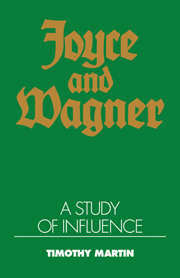6 - The art of arts
Published online by Cambridge University Press: 05 November 2011
Summary
Fiction … must strenuously aspire to the plasticity of sculpture, the colour of painting, and to the magic suggestiveness of music – which is the art of arts.
Conrad, Preface to The Nigger of the “Narcissus”But, of course, the real villain is Wagner. He has done more than any man in the nineteenth century towards the muddling of arts.
Forster, Howards EndIn chapter 4 of A Portrait, Stephen Dedalus grapples with the question of his vocation, and he begins to test his capacities as an artist. A passage near the chapter's climax explains the attraction that Stephen feels for language, an attraction that, he now understands, is much stronger than his recent fascination with the mystical powers of the priesthood:
He drew forth a phrase from his treasure and spoke it softly to himself.
–A day of dappled seaborne clouds.
The phrase and the day and the scene harmonised in a chord. Words. Was it their colours? He allowed them to glow and fade, hue after hue: sunrise gold, the russet and green of apple orchards, azure of waves, the greyfringed fleece of clouds. No, it was not their colours: it was the poise and balance of the period itself. Did he then love the rhythmic rise and fall of words better than their associations of legend and colour? …
- Type
- Chapter
- Information
- Joyce and WagnerA Study of Influence, pp. 142 - 164Publisher: Cambridge University PressPrint publication year: 1991

